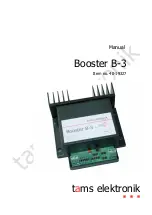
Page 11 of
15
Ethernet Extension Experts
For troubleshooting, first examine the backbone wiring pair and make sure you have solid
connections. The Interlink Sync LED will be lit solid Green with rapid pulsing on each 864
unit to show proper connection and pairing. If the Interlink Sync LED Link is flashing slow
to fast and never goes solid …. Then follow the steps below:
1) Make sure your wiring is straight through and not connected to any Telco punch
down block; If so remove from the block and use Telco butt clips to bridge wire.
2) Check for a firm connection of the RJ-45 connections in each 864 unit,
and power is applied to the 864 DSLAM& 860 CPE units.
3) You can easily isolate any issue by performing an out of the box test confirm either the
864 Kit or your wiring. It is possible an outside interference has been introduced into your
wiring.
Performance Settings
If you are experiencing performance issues with your Ethernet connection you
may use the following Dip switch settings to adjust your application. For Dip
switch 2-4 you must toggle both symmetrically, in other words the CO and CPE
must match. If you turn 3 up on the CO you must do so for the CPE and vice-
versa.
Dip Switch 1: Toggles the 860 Pro for either CO or CPE mode. (CO mode Up, CPE
mode Down)
Dip Switch 2: This toggles your 860 Pro for either Interleave or Fast mode – Default
setting is set to Fast which is preferred for streaming multimedia, where an occasional
dropped bit is acceptable, but lags are less so. Interleave channel works better for file
transfers, where the delivered data must be error free but latency incurred by the
retransmission of errored packets is acceptable.
Dip Switch 3: This toggles symmetrical/asymmetrical mode for dsl transmissions.
Symmetrical balances out the download/upload speed for transmitting data packets.
Asymmetrical mode weighs in favor of download speed while sacrificing upload speed
bandwidth. We suggest flipping Dip switch 3 Up (OFF) at a distance of 1,500 feet or less.
Dip Switch 4: This toggles the Signal Noise Ratio (SNR). Default is set to 9dB which is
excellent for long distance communications whereas flipping the switch Up (OFF) toggles
6dB mode. If you experience issues of noise bleeding over the lines or high interference
in your environment it is suggested that you switch to 6dB mode and change to interleave
mode. This will help clean up any noise bleeding over your cabling.

































